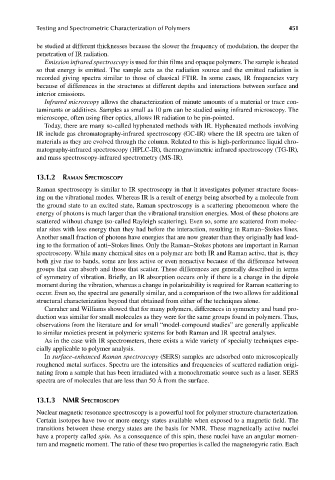Page 488 - Carrahers_Polymer_Chemistry,_Eighth_Edition
P. 488
Testing and Spectrometric Characterization of Polymers 451
be studied at different thicknesses because the slower the frequency of modulation, the deeper the
penetration of IR radiation.
Emission infrared spectroscopy is used for thin films and opaque polymers. The sample is heated
so that energy is emitted. The sample acts as the radiation source and the emitted radiation is
recorded giving spectra similar to those of classical FTIR. In some cases, IR frequencies vary
because of differences in the structures at different depths and interactions between surface and
interior emissions.
Infrared microscopy allows the characterization of minute amounts of a material or trace con-
taminants or additives. Samples as small as 10 μm can be studied using infrared microscopy. The
microscope, often using fiber optics, allows IR radiation to be pin-pointed.
Today, there are many so-called hyphenated methods with IR. Hyphenated methods involving
IR include gas chromatography-infrared spectroscopy (GC-IR) where the IR spectra are taken of
materials as they are evolved through the column. Related to this is high-performance liquid chro-
matography-infrared spectroscopy (HPLC-IR), thermogravimetric infrared spectroscopy (TG-IR),
and mass spectroscopy-infrared spectrometry (MS-IR).
13.1.2 RAMAN SPECTROSCOPY
Raman spectroscopy is similar to IR spectroscopy in that it investigates polymer structure focus-
ing on the vibrational modes. Whereas IR is a result of energy being absorbed by a molecule from
the ground state to an excited state, Raman spectroscopy is a scattering phenomenon where the
energy of photons is much larger than the vibrational transition energies. Most of these photons are
scattered without change (so-called Rayleigh scattering). Even so, some are scattered from molec-
ular sites with less energy than they had before the interaction, resulting in Raman–Stokes lines.
Another small fraction of photons have energies that are now greater than they originally had lead-
ing to the formation of anti–Stokes lines. Only the Raman–Stokes photons are important in Raman
spectroscopy. While many chemical sites on a polymer are both IR and Raman active, that is, they
both give rise to bands, some are less active or even nonactive because of the difference between
groups that can absorb and those that scatter. These differences are generally described in terms
of symmetry of vibration. Briefly, an IR absorption occurs only if there is a change in the dipole
moment during the vibration, whereas a change in polarizability is required for Raman scattering to
occur. Even so, the spectral are generally similar, and a comparison of the two allows for additional
structural characterization beyond that obtained from either of the techniques alone.
Carraher and Williams showed that for many polymers, differences in symmetry and band pro-
duction was similar for small molecules as they were for the same groups found in polymers. Thus,
observations from the literature and for small “model-compound studies” are generally applicable
to similar moieties present in polymeric systems for both Raman and IR spectral analyses.
As in the case with IR spectrometers, there exists a wide variety of specialty techniques espe-
cially applicable to polymer analysis.
In surface-enhanced Raman spectroscopy (SERS) samples are adsorbed onto microscopically
roughened metal surfaces. Spectra are the intensities and frequencies of scattered radiation origi-
nating from a sample that has been irradiated with a monochromatic source such as a laser. SERS
spectra are of molecules that are less than 50 Å from the surface.
13.1.3 NMR SPECTROSCOPY
Nuclear magnetic resonance spectroscopy is a powerful tool for polymer structure characterization.
Certain isotopes have two or more energy states available when exposed to a magnetic fi eld. The
transitions between these energy states are the basis for NMR. These magnetically active nuclei
have a property called spin. As a consequence of this spin, these nuclei have an angular momen-
tum and magnetic moment. The ratio of these two properties is called the magnetogyric ratio. Each
9/14/2010 3:42:13 PM
K10478.indb 451 9/14/2010 3:42:13 PM
K10478.indb 451

